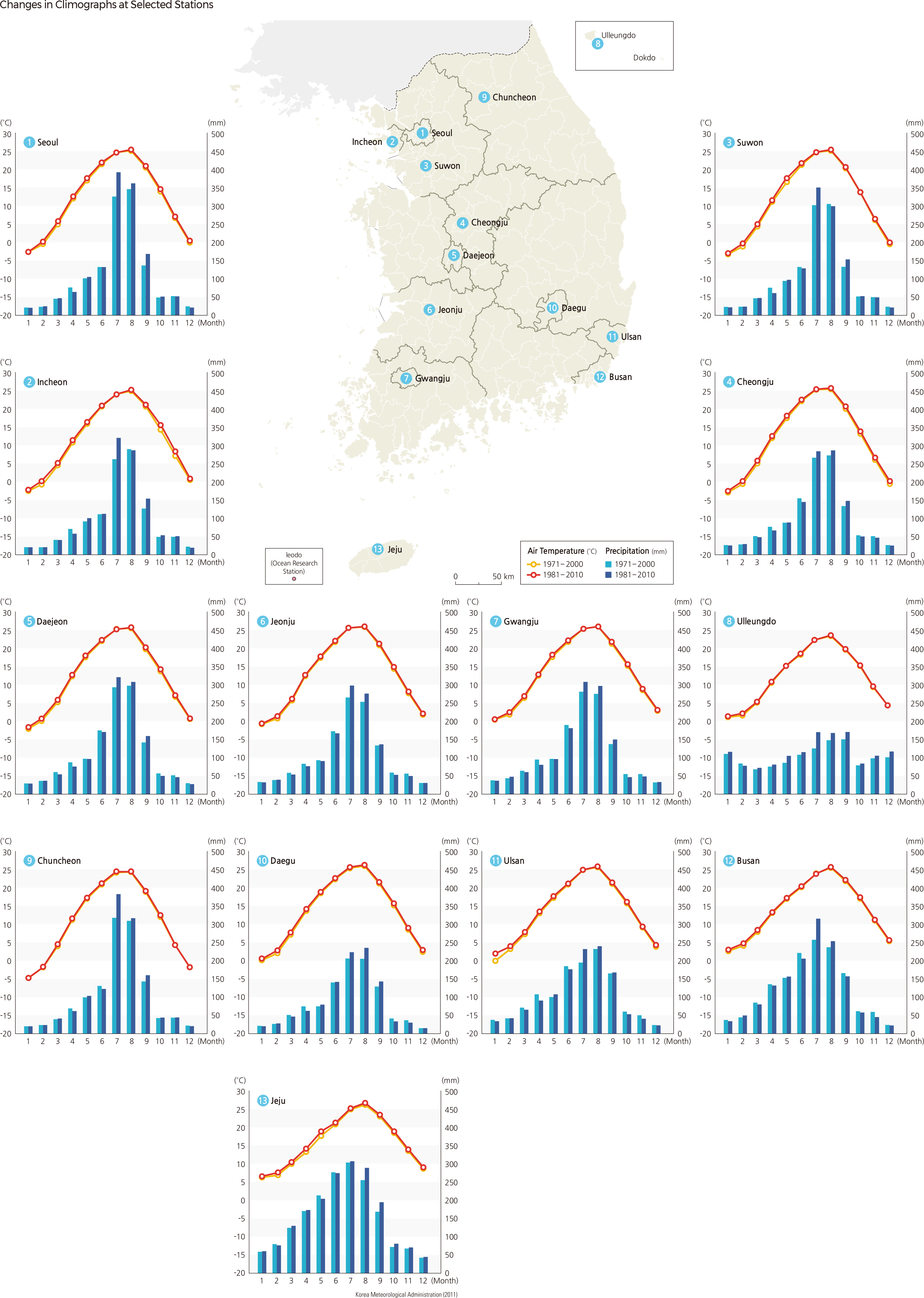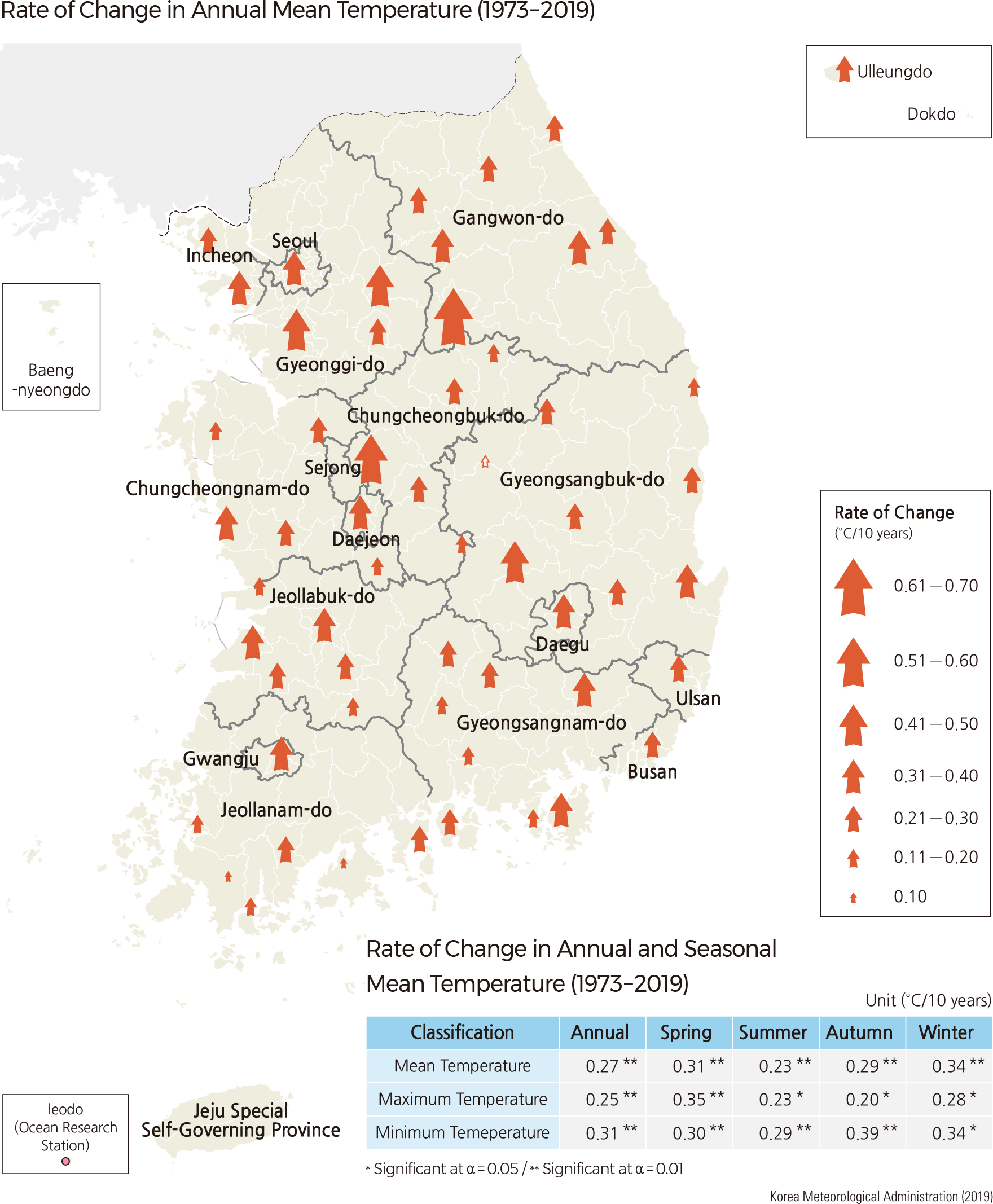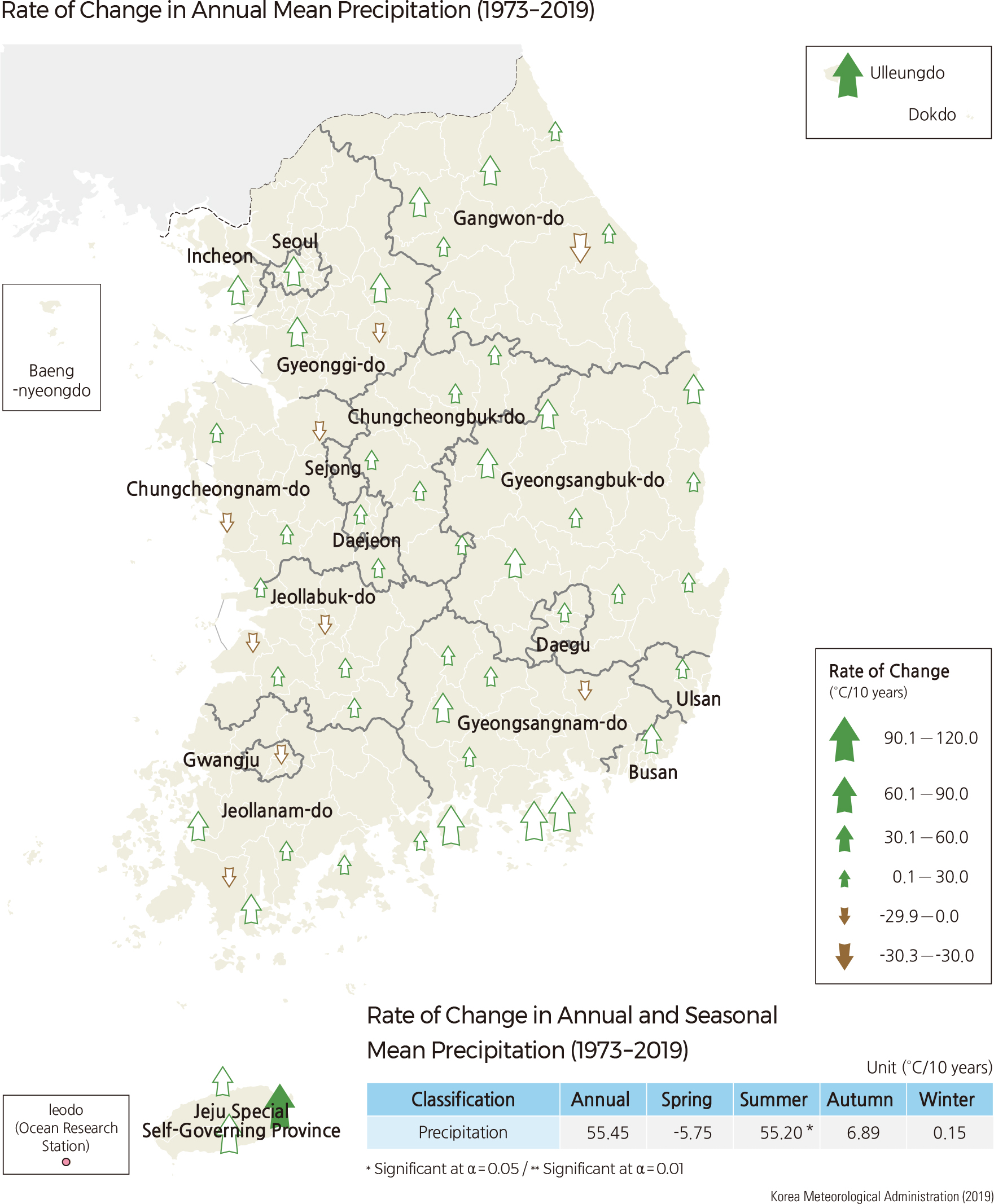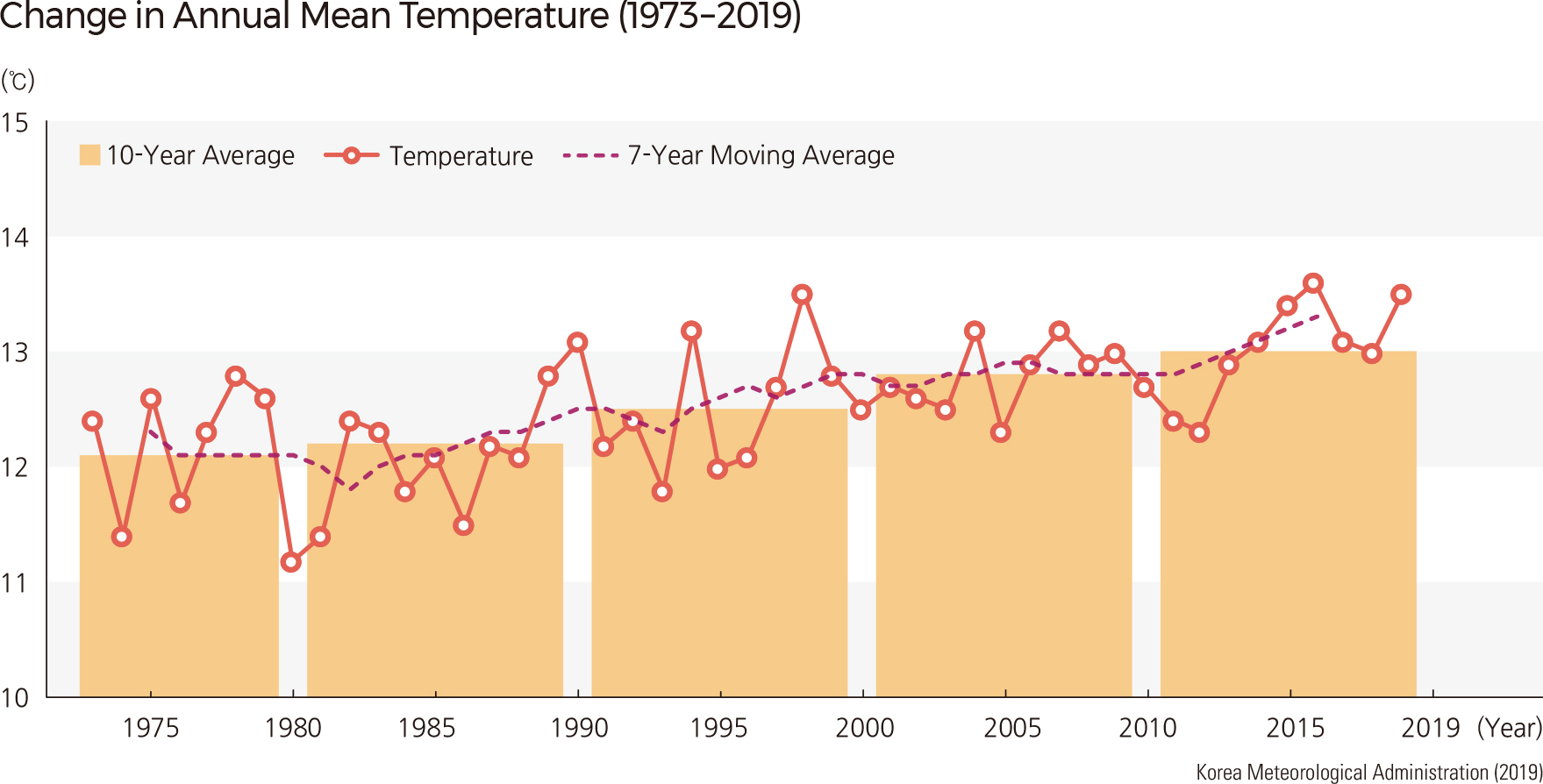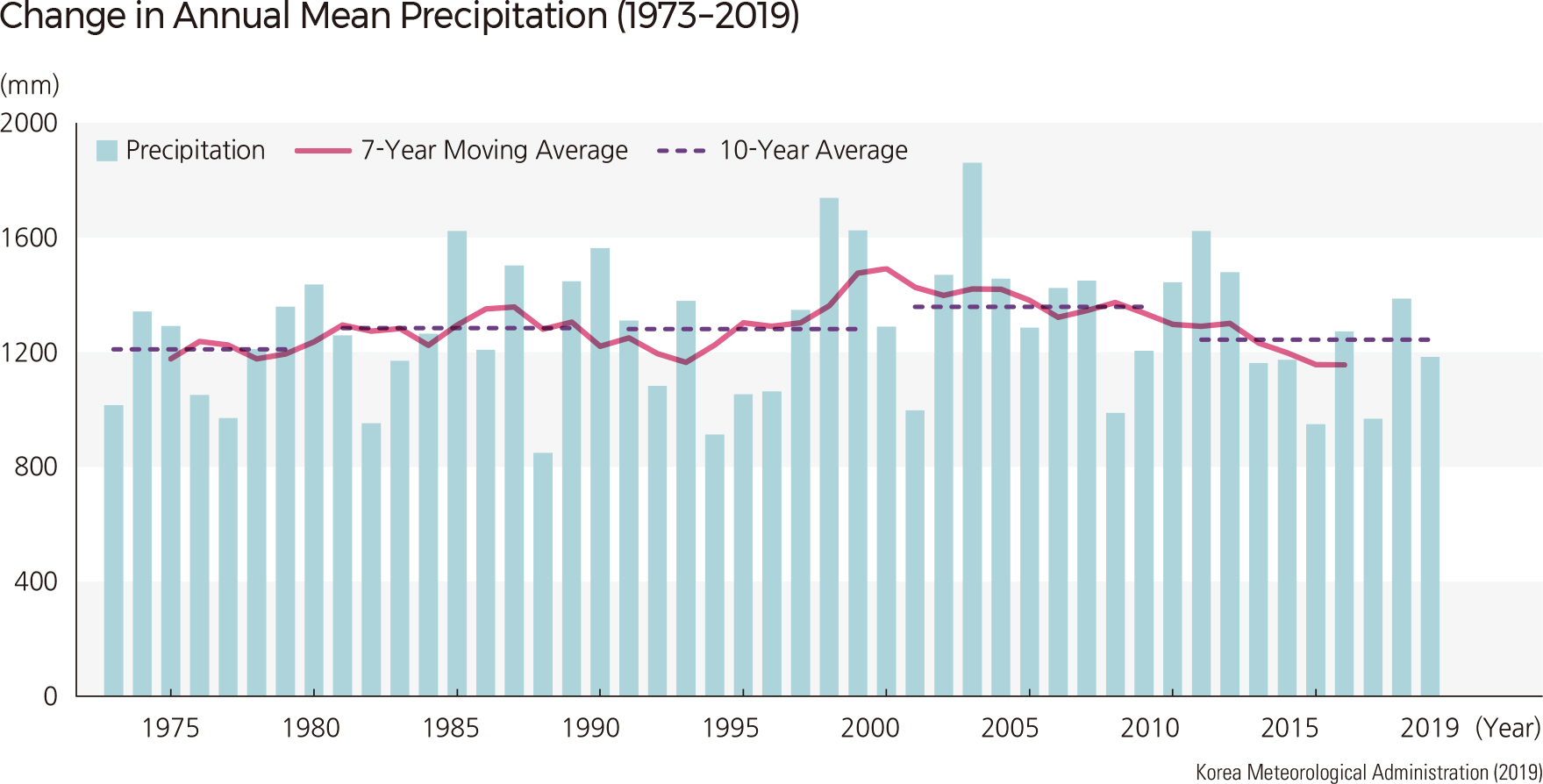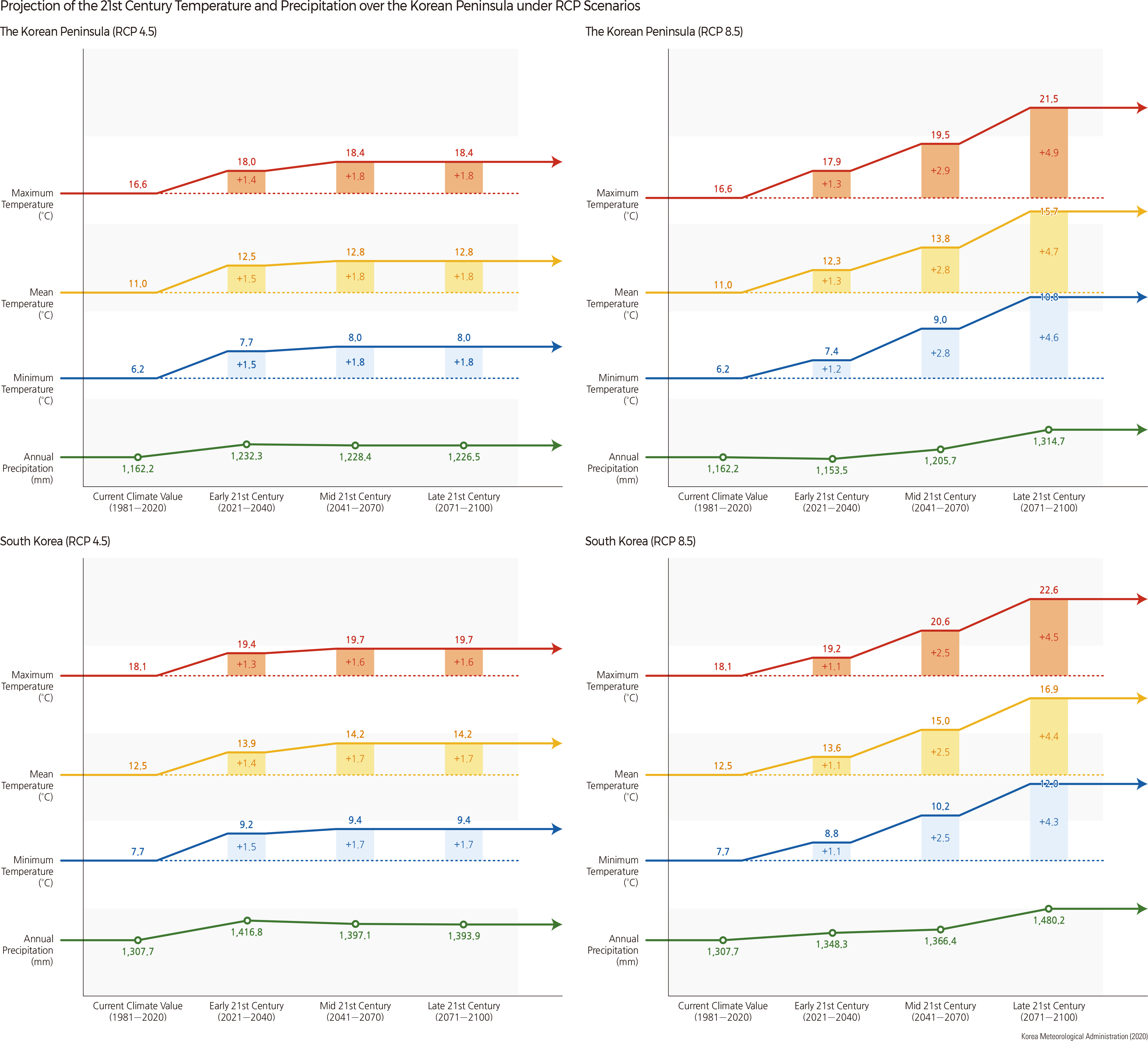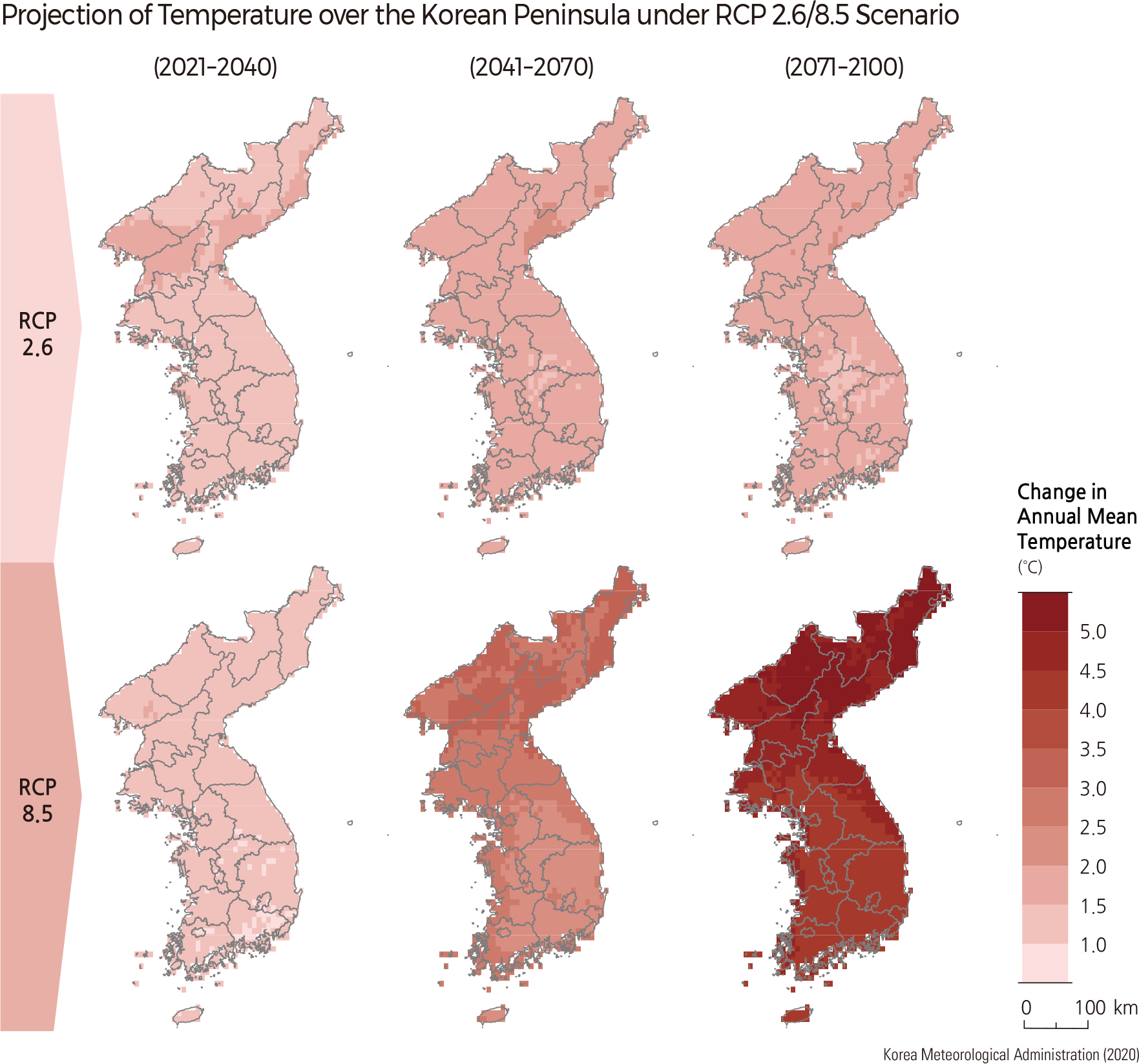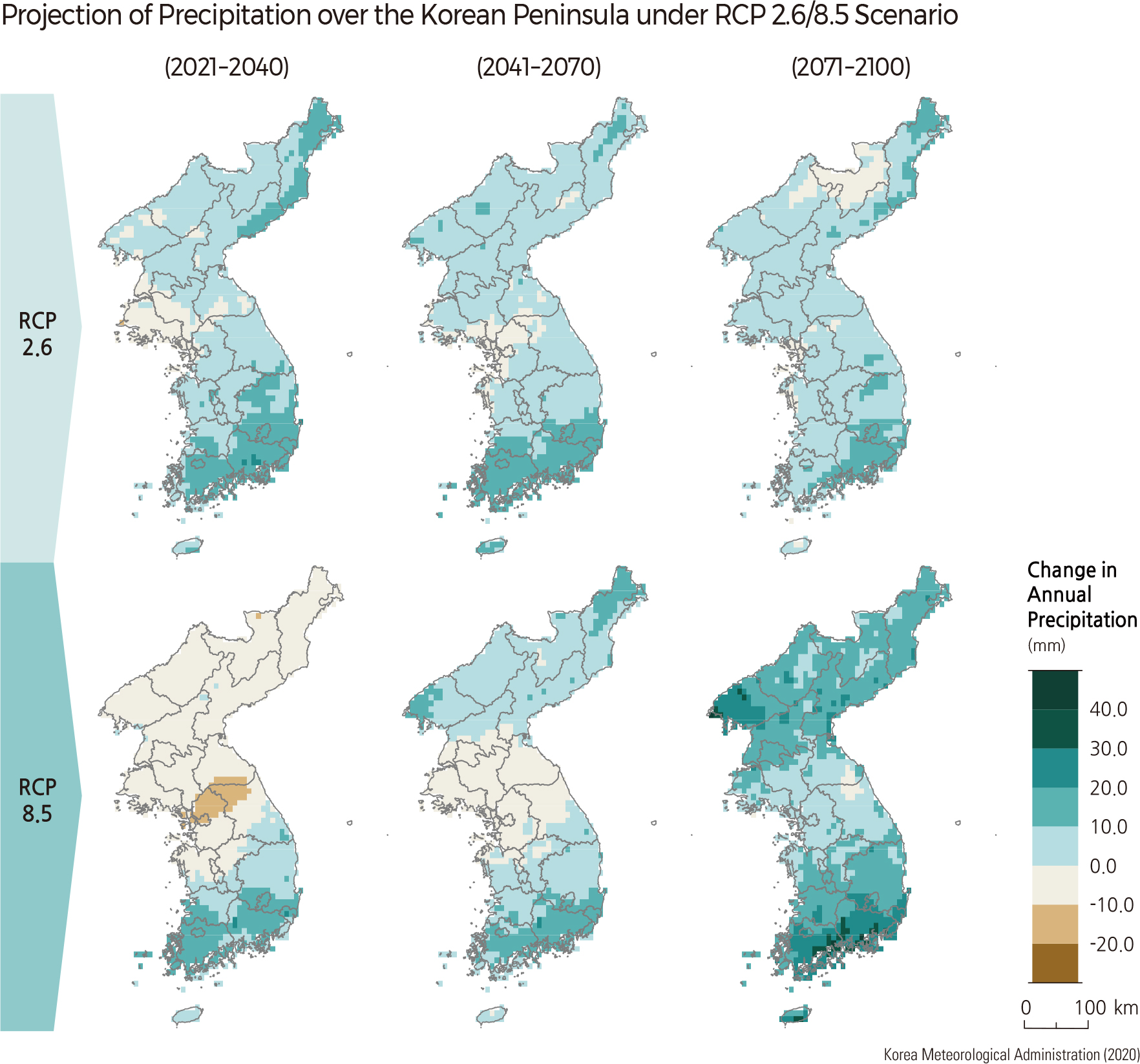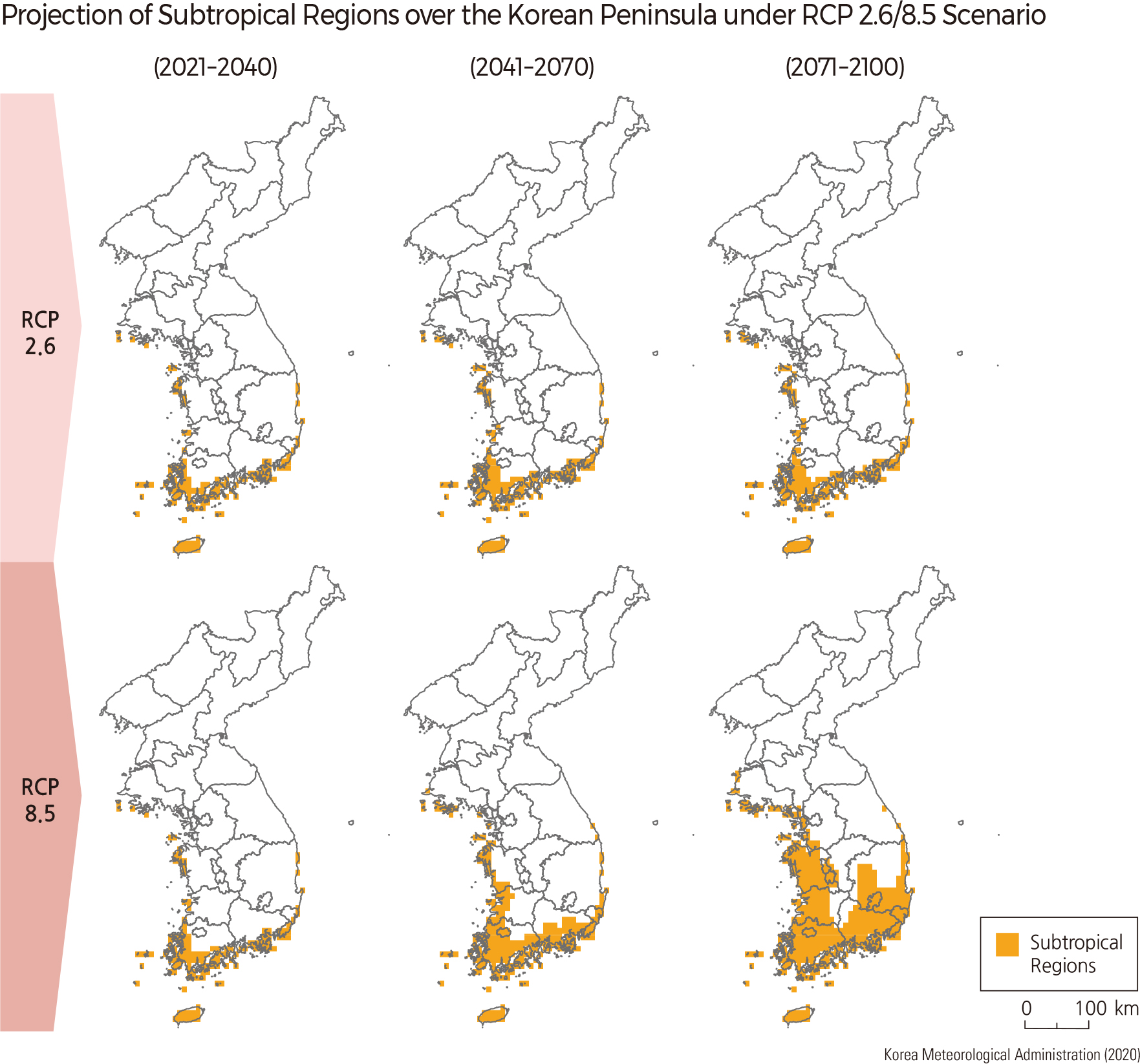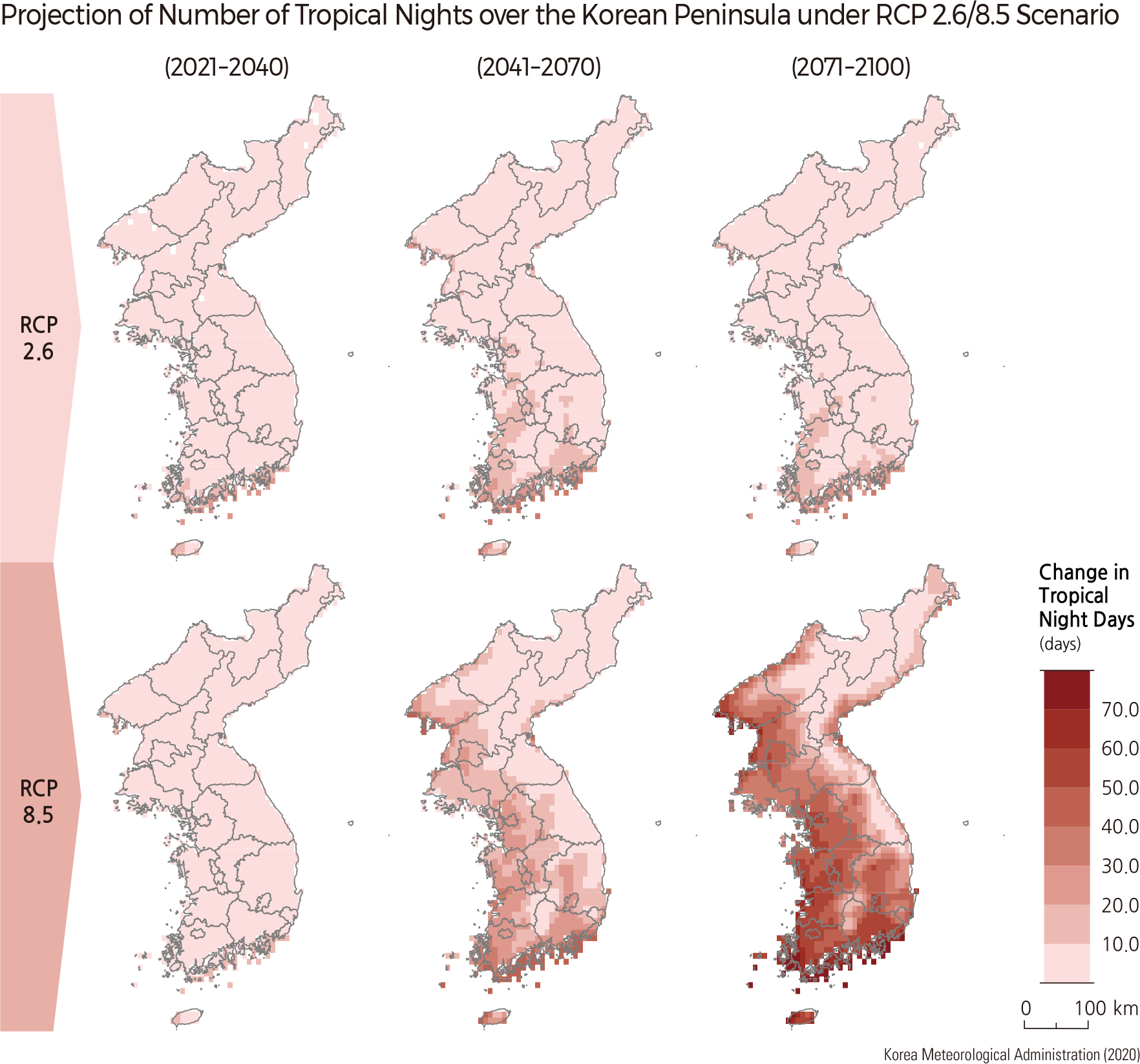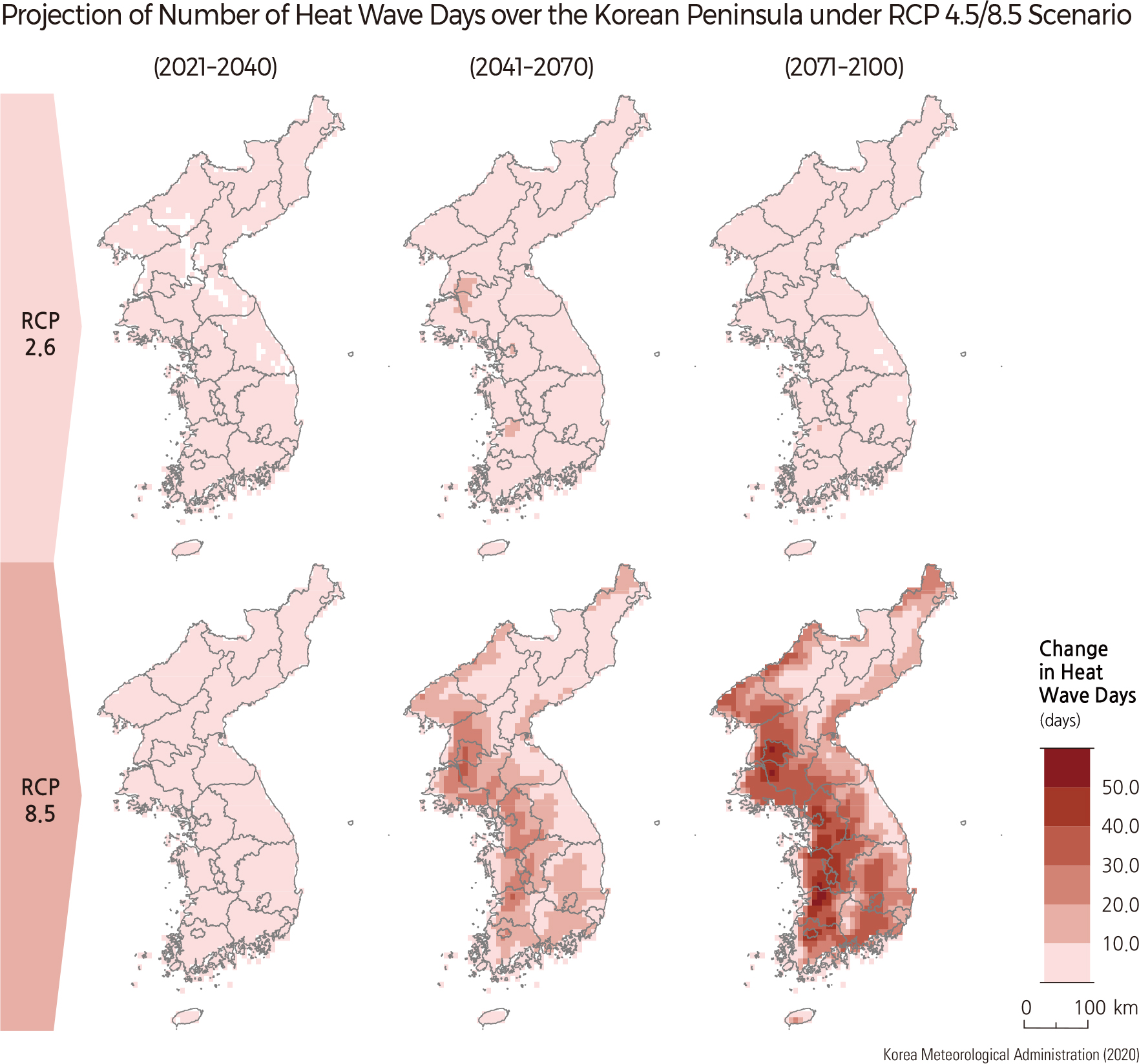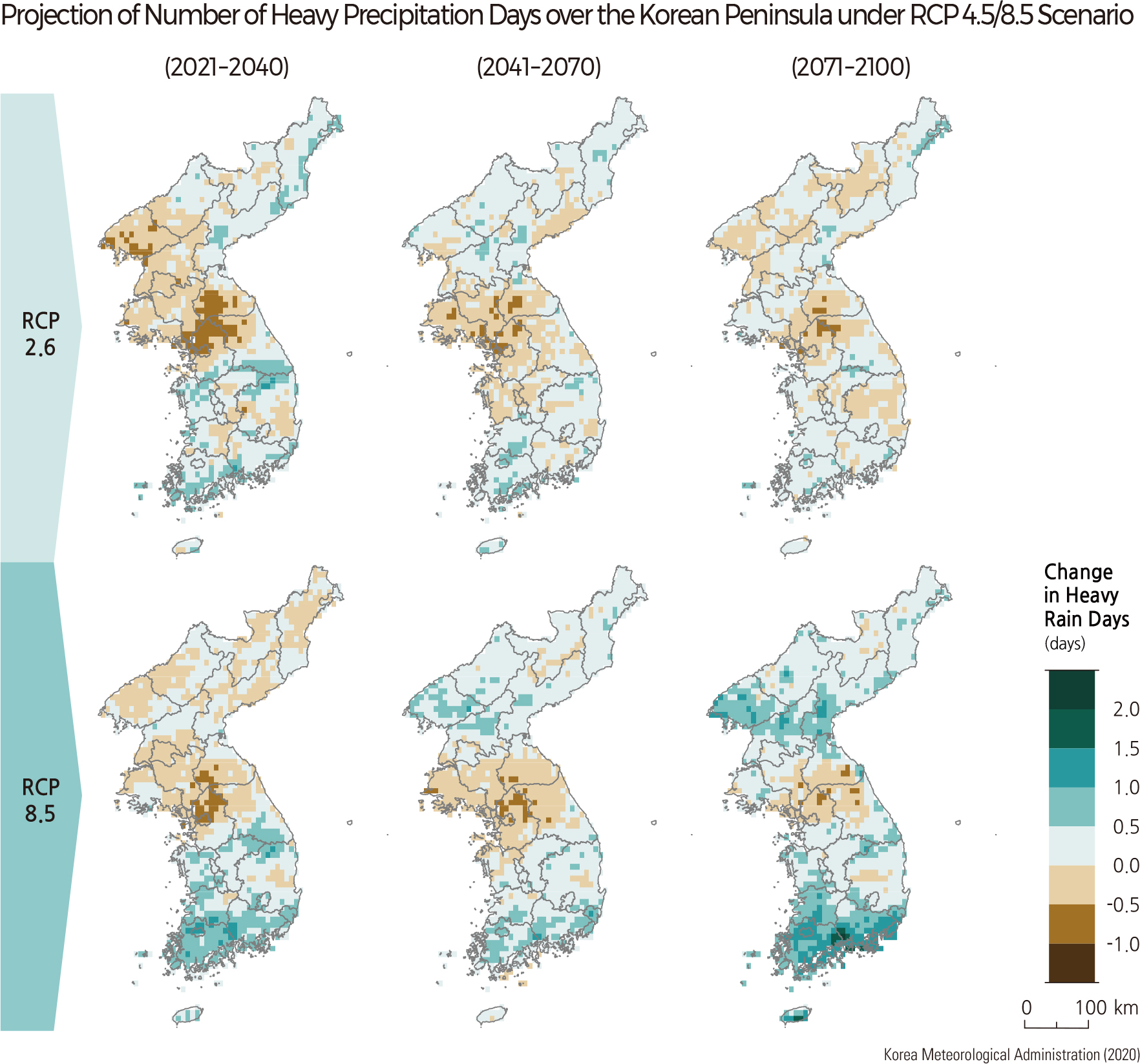English II 2020
There has been an increasing trend in temperature over the past 30 years. According to the climographs, the average monthly temperature of the recent 30 years (1981–2010) is greater than the past 30 years (1971–2000), except for July.
The annual precipitation of the Korean Peninsula experienced a slight increase by around 50 mm on average in the last 30 years (1981–2010). The annual precipitation recorded at 13 observation stations increased by about 3.9% on average compared to the past (1971–2000), while Ulleungdo experienced an 11% increase in precipitation. In most areas, summer precipitation has increased, while precipitation in spring and autumn has decreased.
The rate of change in annual mean temperature, 0.27˚C/10 years, clearly shows a warming trend in Korea. All the areas except Mungyeong have experienced a rise in annual mean temperature between 0.10˚C and 0.61˚C for every 10 years. Wonju has experienced the greatest increase in temperature at 0.61˚C for every 10 years. The annual mean temperature increases at a greater rate in metropolitan areas than the national average rate of change. The highest rate of change in annual mean temperature occurs in Daejeon (0.39˚C/10 years). Winters (0.34˚C/10 years) have experienced the greatest increase in temperature, while summers (0.23˚C/10 years) have experienced the lowest temperature increase.
The annual mean temperature of the Korean Peninsula is expected to rise steadily throughout the 21st century. According to the Representative Concentration Pathways (RCP) 2.6 scenario, the increasing trend projected from the current mean temperature (11˚C) in the early 21st century is similar to that in the RCP 8.5 scenario. However, the increasing rate is expected to slow down during the mid-21st century. The annual mean temperature in the late 21st century is projected to be 12.8˚C in the RCP 4.5 scenario, corresponding to the current average temperature in the southeastern coastal region. According to the RCP 8.5 scenario, the magnitude of the increase in annual mean temperature gets greater after the second half of the 21st century. The annual mean temperature in the late 21st century is projected to be 15.7˚C, corresponding to the current average temperature of Jejudo (15.8˚C).
According to the RCP 2.6 scenario, the increasing rates of the maximum and minimum temperatures are projected to decrease toward the second half of the 21st century. These temperatures will remain the same in the middle and second half of the 21st century. According to the RCP 8.5 scenario, the increasing trends for the maximum and minimum temperatures accelerate toward the late 21st century. The diurnal temperature range will increase as the maximum temperature rises faster than the minimum temperature.
The annual precipitation for the Korean Peninsula is projected to rise until the late 21st century. The RCP 2.6 scenario and the RCP 8.5 scenario expect the annual precipitation in the late 21st century to be 1,226.5 mm and 1,314.7 mm, respectively, corresponding to the current annual precipitation in the interior Chungcheongbuk-do and the western coastal region of the Peninsula.
The annual mean temperature of the Korean Peninsula is projected to continue to increase. According to the RCP 2.6 scenario, the increasing trend in the early 21st century will have a rate similar to that of the RCP 8.5 scenario, but it will slow down over time. The annual mean temperature will remain the same in the middle and second half of the 21st century. The annual mean temperature in the late 21st century is predicted to be 14.2˚C, corresponding to the current value of Geoje. According to the RCP 8.5 scenario, the increasing trend for temperature accelerates from the mid-21st century to the late 21st century. In the scenario, the annual mean temperature in the late 21st century is projected to be 16.9˚C, which exceeds the current annual mean temperature of Seogwipo (16.6˚C). The annual mean maximum and minimum temperatures are also expected to increase steadily until the late 21st century.
Annual mean precipitation in South Korea in the late 21st century projected in the RCP 2.6 and RCP 8.5 scenarios are 1,393.9 mm and 1,480.2 mm, respectively, which correspond to the current annual precipitation in the interior Jeollanam-do and Gyeongsangnam-do, respectively. The RCP 2.6 scenario shows a greater increasing rate in the annual mean precipitation during the early 21st century than the RCP 8.5 scenario. But the annual mean precipitation will decrease slightly from the mid-21st century. According to the RCP 8.5 scenario, the annual mean precipitation will slightly increase during the early and mid-21st century. Then, the annual mean precipitation appears to increase largely right after the mid-21st century.
According to the Trewartha climate classification, the southern coast of the Korean Peninsula, including Jejudo, is classified as a humid subtropical climate region. As global warming accelerates, the boundary of the subtropical climate region is projected to move gradually to the north. According to the RCP 2.6 scenario, in the late 21st century, Jeollanam-do, Jeollabuk-do, the west coast of Chungcheongnam-do, the west coast of Gyeonggi-do, and Gyeongsangnam-do are expected to belong to subtropical climate regions. The RCP 8.5 scenario predicts South Korea except for the mountainous region in Gangwon-do to be classified as subtropical climate regions in the late 21st century.
The annual mean number of tropical nights increases sub-stantially in the late 21st century. According to the RCP 2.6 scenario, the annual mean number of tropical nights will increase during the mid-21st century but will slightly decrease in the late 21st century. The RCP 8.5 scenario predicts that most areas of the Peninsula except some major mountain highlands will have a much greater annual number of tropical nights than today in the late 21st century. Afterward, as climate change becomes more intensified, it is anticipated that areas with tropical nights will expand to the mountain highlands.
According to the RCP 2.6 and 8.5 scenarios, the increase in heat wave days will be greatly accelerated in the lowlands. Compared to the RCP 2.6 scenario, the annual number of heat wave days will be further accelerated in the RCP 8.5 scenario. The number of heavy precipitation days is projected to increase in most regions with wide variations depending on time, region, and scenario. |
